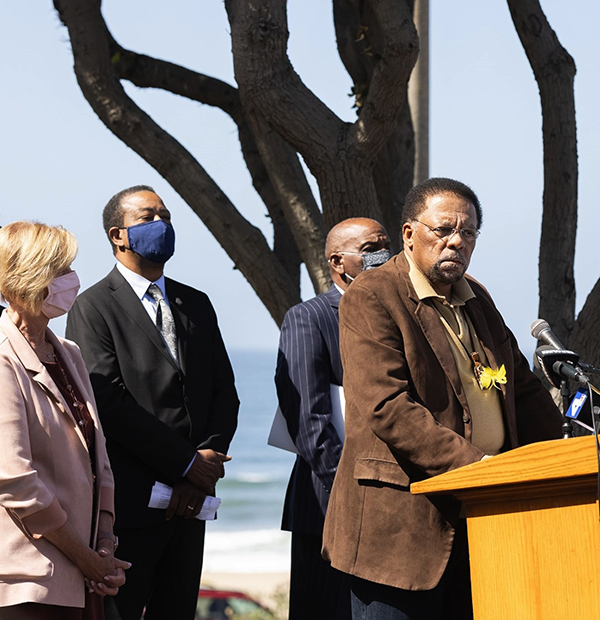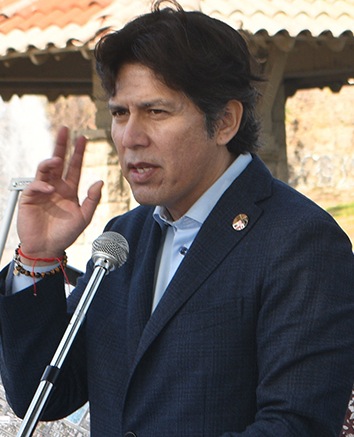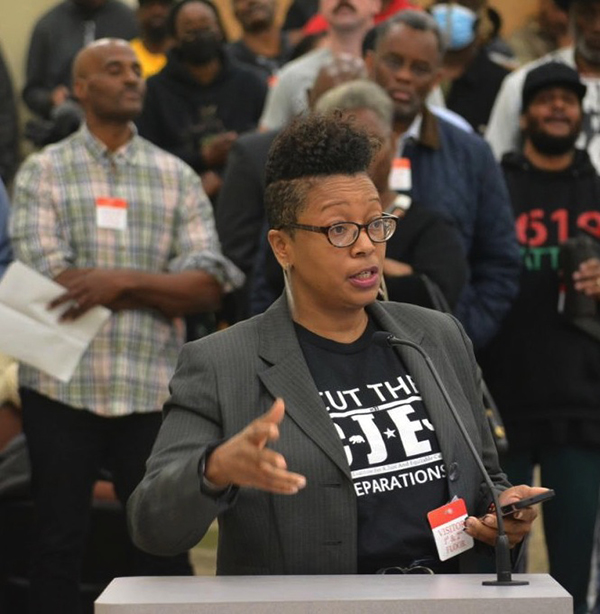Wave Staff Report
LOS ANGELES — Efforts by state and county officials to return a prime piece of beachfront property in Manhattan Beach to the descendants of Willa and Charles Bruce this year opened the door to a possible example of how reparations could eventually be made to the Black community.
The state Legislature approved a bill in September that removed state restrictions on the beachfront property, allow the county to transfer the property to descendants of the Bruce family.
Gov. Gavin Newsom signed the bill Sept. 30, appearing at the Manhattan Beach property with members of the Bruce family and state and county officials who steered the bill through the Legislature.
“The people of California of all walks of life have unanimously spoken and have said that racism, bias, patriarchy, misogyny and legal coverups, will no longer be tolerated in our state,” said Chief Duane Yellow Feather Shepard, a spokesman and historian for the Bruce family. “This is a victory for the faithful and oppressed in this country that has been long in coming for 450 years.”
The saga of the Bruce family’s beachfront property is one familiar to many Blacks who lived shortly after the start of the 20th century.
Willa and Charles Bruce purchased land on Manhattan Beach in 1912 for $1,225. They eventually added some other parcels and created a beach resort catering to Black residents, who had few options at the time for enjoying the California coast.
Complete with a bath house, dance hall and cafe, the resort attracted other Black families who purchased adjacent land and created what they hoped would be an oceanfront retreat.
But the resort quickly became a target of the area’s white populace, leading to acts of vandalism, attacks on vehicles of Black visitors and even a 1920 attack by the Ku Klux Klan.
The Bruces were undeterred and continued operating their small enclave, but under increasing pressure, the city moved to condemn their property and other surrounding parcels in 1924, seizing it through eminent domain under the pretense of planning to build a city park.
The resort was forced out of business, and the Bruces and other Black families ultimately lost their land in 1929.
The families sued, claiming they were the victims of a racially motivated removal campaign. The Bruces were eventually awarded some damages, as were other displaced families. But the Bruces were unable to reopen their resort anywhere else in town.
The property sat vacant for decades, until 1960 when a small park was built on a portion of the seized land because city officials fearing the evicted families could take new legal action if the property wasn’t used for the purpose for which it was seized.
The exact parcel of land the Bruces owned was eventually transferred to the state and then to the county in 1995, where it has served as the Los Angeles County Lifeguard Training Headquarters.
“What happened to the Bruce family is an ugly part of America that continues to this day,” said State Sen. Steven Bradford, who introduced the bill in the state Legislature to return the land to the Bruce family.
“This country’s racist practices have tortured and killed African Americans physically, mentally, emotionally and spiritually and it is hard to put a price on what we have endured,” he added. “The state has a debt and an obligation to recognize these injustices and make amends.”
County Supervisor Janice Hahn took up the cause from the county’s end.
“I am deeply embarrassed by what happened right here in L.A. County,” Hahn said in May. “I grew up here and I didn’t hear about Bruce’s Beach until recently. I knew about the horrible things happening to Black people in Selma, Montgomery and Birmingham, but I naively thought L.A. County was better than that.
“I feel it is my obligation to do what I can to make up for this injustice,” she said.
Earlier this month, the county Board of Supervisors approved a state grant deed modification that clears the way for the county to transfer Bruce’s Beach to the Bruce family.
The board directed the county CEO in October to work with staff from the Treasurer and Tax Collector’s Office to identify and vet potential claimants. The county also needs to determine with the family how to transfer the property in a way that eases the property tax burden on the descendants when they take possession.
The state law gives the county the leeway to handle the transfer however it determines to be in the best interest of the county and the general public.
“We will be a model for the country in how you can right a wrong, even if it’s 100 years old,” Hahn said. “I hope we spend the next 100 years in this country looking at all the possible opportunities we have to tell the truth and then reconcile and amend and heal.”













